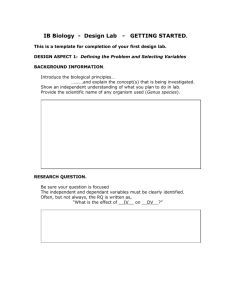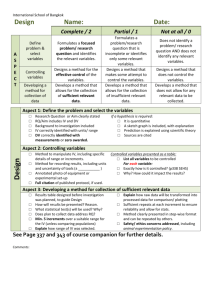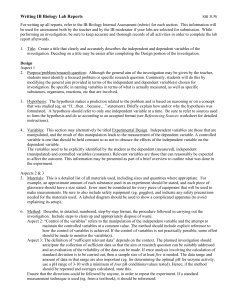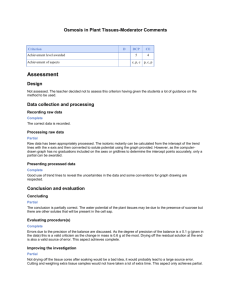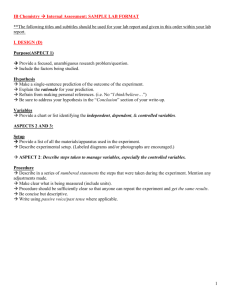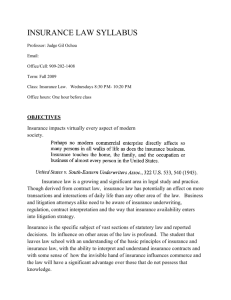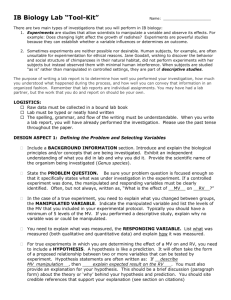Design - Highland Park Senior High School
advertisement
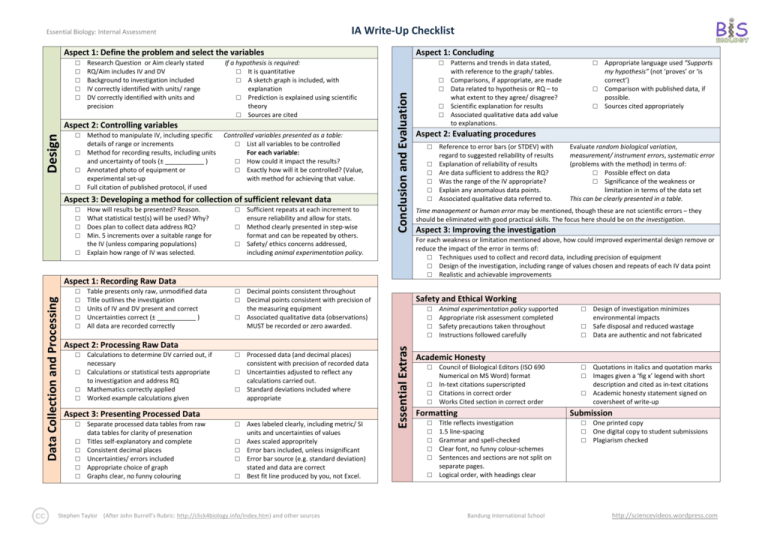
Essential Biology: Internal Assessment IA Write‐Up Checklist Aspect 1: Define the problem and select the variables Research Question or Aim clearly stated RQ/Aim includes IV and DV Background to investigation included IV correctly identified with units/ range DV correctly identified with units and precision If a hypothesis is required: □ It is quantitative □ A sketch graph is included, with explanation □ Prediction is explained using scientific theory □ Sources are cited Design Aspect 2: Controlling variables □ □ □ □ Method to manipulate IV, including specific Controlled variables presented as a table: details of range or increments □ List all variables to be controlled Method for recording results, including units For each variable: and uncertainty of tools (± ___________ ) □ How could it impact the results? Annotated photo of equipment or □ Exactly how will it be controlled? (Value, experimental set‐up with method for achieving that value. Full citation of published protocol, if used Aspect 3: Developing a method for collection of sufficient relevant data □ □ □ □ □ How will results be presented? Reason. What statistical test(s) will be used? Why? Does plan to collect data address RQ? Min. 5 increments over a suitable range for the IV (unless comparing populations) Explain how range of IV was selected. □ □ □ Sufficient repeats at each increment to ensure reliability and allow for stats. Method clearly presented in step‐wise format and can be repeated by others. Safety/ ethics concerns addressed, including animal experimentation policy. □ Conclusion and Evaluation □ □ □ □ □ Aspect 1: Concluding □ □ □ Aspect 2: Processing Raw Data □ □ □ □ Calculations to determine DV carried out, if necessary Calculations or statistical tests appropriate to investigation and address RQ Mathematics correctly applied Worked example calculations given □ □ □ Processed data (and decimal places) consistent with precision of recorded data Uncertainties adjusted to reflect any calculations carried out. Standard deviations included where appropriate Aspect 3: Presenting Processed Data □ □ □ □ □ □ Separate processed data tables from raw data tables for clarity of presenation Titles self‐explanatory and complete Consistent decimal places Uncertainties/ errors included Appropriate choice of graph Graphs clear, no funny colouring □ □ □ □ □ Decimal points consistent throughout Decimal points consistent with precision of the measuring equipment Associated qualitative data (observations) MUST be recorded or zero awarded. Axes labeled clearly, including metric/ SI units and uncertainties of values Axes scaled appropritely Error bars included, unless insignificant Error bar source (e.g. standard deviation) stated and data are correct Best fit line produced by you, not Excel. □ Aspect 2: Evaluating procedures □ □ □ □ □ □ Reference to error bars (or STDEV) with regard to suggested reliability of results Explanation of reliability of results Are data sufficient to address the RQ? Was the range of the IV appropriate? Explain any anomalous data points. Associated qualitative data referred to. Evaluate random biological variation, measurement/ instrument errors, systematic error (problems with the method) in terms of: □ Possible effect on data □ Significance of the weakness or limitation in terms of the data set This can be clearly presented in a table. Time management or human error may be mentioned, though these are not scientific errors – they should be eliminated with good practical skills. The focus here should be on the investigation. Aspect 3: Improving the investigation Safety and Ethical Working □ □ □ □ Essential Extras Data Collection and Processing Aspect 1: Recording Raw Data Table presents only raw, unmodified data Title outlines the investigation Units of IV and DV present and correct Uncertainties correct (± ___________ ) All data are recorded correctly □ □ □ Appropriate language used “Supports my hypothesis” (not ‘proves’ or ‘is correct’) Comparison with published data, if possible. Sources cited appropriately For each weakness or limitation mentioned above, how could improved experimental design remove or reduce the impact of the error in terms of: □ Techniques used to collect and record data, including precision of equipment □ Design of the investigation, including range of values chosen and repeats of each IV data point □ Realistic and achievable improvements □ □ □ □ □ □ □ □ Patterns and trends in data stated, with reference to the graph/ tables. Comparisons, if appropriate, are made Data related to hypothesis or RQ – to what extent to they agree/ disagree? Scientific explanation for results Associated qualitative data add value to explanations. Animal experimentation policy supported Appropriate risk assessment completed Safety precautions taken throughout Instructions followed carefully □ □ □ Design of investigation minimizes environmental impacts Safe disposal and reduced wastage Data are authentic and not fabricated Academic Honesty □ □ □ □ Council of Biological Editors (ISO 690 Numerical on MS Word) format In‐text citations superscripted Citations in correct order Works Cited section in correct order Formatting □ □ □ □ □ □ Title reflects investigation 1.5 line‐spacing Grammar and spell‐checked Clear font, no funny colour‐schemes Sentences and sections are not split on separate pages. Logical order, with headings clear □ □ □ Quotations in italics and quotation marks Images given a ‘fig x’ legend with short description and cited as in‐text citations Academic honesty statement signed on coversheet of write‐up Submission □ □ □ One printed copy One digital copy to student submissions Plagiarism checked Stephen Taylor (After John Burrell’s Rubric: http://click4biology.info/index.htm) and other sources Bandung International School http://sciencevideos.wordpress.com
